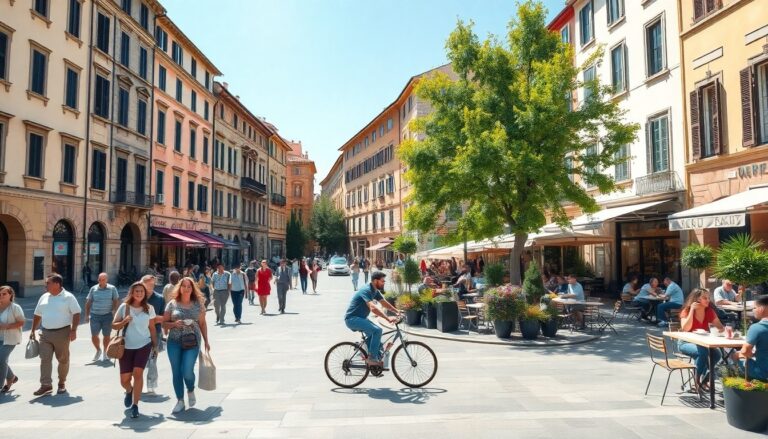Argomenti trattati
In Italy, the quality of life varies significantly from one province to another, as highlighted by a recent study. Conducted by ItaliaOggi and Ital Communications, in collaboration with Sapienza University of Rome, this annual report evaluates 107 provinces across nine crucial categories, including business and employment, environment, education, and cultural tourism.
The investigation reveals that the overall quality of life in Italy has seen a decline. Records show that only 60 out of 107 provinces are classified as having a good or acceptable quality of life, reflecting a decrease from previous years. This report not only highlights the top performers but also emphasizes the persistent gaps between northern and southern regions.
Overview of the 2025 quality of life rankings
The 27th edition of the quality of life survey has been conducted, analyzing 92 indicators across nine key categories. Provinces are awarded points based on their performance, with the highest-scoring province receiving 1,000 points and the lowest receiving none. These provinces are classified into four categories: Good, Acceptable, Fair, and Poor.
Key findings from the rankings
The results indicate a troubling trend of declining quality of life in many regions. In the southern provinces, only L’Aquila achieved an acceptable quality of life. Other areas, such as Caltanissetta and Crotone, ranked near the bottom. Caltanissetta maintained its position at 107th for the second consecutive year, trailing behind Crotone and Reggio Calabria. In contrast, northern provinces like Milan and Bolzano continue to secure the top positions in the rankings.
Milan has retained its position as the city with the highest quality of life, attributed to its robust services, economic vitality, and effective infrastructure management. This comes despite ongoing challenges related to social safety. Bolzano remains in second place, while Bologna has made a notable debut in third.
The South-North divide
Data indicates a persistent divide between northern and southern Italy. Northern provinces generally outperform their southern counterparts. Notably, provinces such as Pordenone and Gorizia have experienced significant drops in their rankings, highlighting a shift in the dynamics of quality of life across the country.
Insights into specific categories
When examining specific categories, trends of improvement and decline become evident. The tourism and culture sector reflects a shift toward smaller cities, increasingly favored by travelers seeking less commercialized experiences. Bolzano has emerged as a leader in the tourism category, followed by Trieste and Rimini. This trend indicates a preference for destinations that offer authentic experiences over traditional hotspots.
Furthermore, the environment category revealed that Bolzano also excels in environmental quality, underscoring its commitment to sustainable practices. While cities like Milan and Rome face significant environmental challenges, smaller provinces are making strides, suggesting a potential shift in tourism trends.
The evidence
Documents in our possession show that the tourism and environment sectors are evolving. Emerging trends indicate a marked preference for smaller cities, particularly in terms of tourism and environmental sustainability.
The reconstruction
In recent years, Bolzano has consistently ranked high in both tourism and environmental quality. This analysis outlines key timelines and developments that have contributed to Bolzano’s rise, particularly in response to travelers’ increasing desire for authentic experiences.
Key players
Bolzano, Trieste, and Rimini are significant players in this evolving landscape. Their strategies to promote sustainable practices and authentic tourism experiences are reshaping travel preferences.
The implications
The findings point to a crucial shift in tourism dynamics. As travelers prioritize environmental quality and authentic experiences, larger cities may need to adapt to remain competitive.
What happens next
Looking ahead, it is expected that more cities will follow Bolzano’s lead in enhancing their tourism and environmental strategies. This shift may redefine the travel landscape in the coming years.
The disparities in Italy’s quality of life
The findings from the latest quality of life report highlight significant disparities within Italy. While certain provinces demonstrate robust growth and prosperity, others encounter substantial challenges that necessitate immediate attention. This analysis underscores the urgent need for targeted improvements in underperforming regions, while advocating for a collaborative approach to enhance the overall quality of life across the nation.
The role of policymakers
Moving forward, it is essential for policymakers to confront these inequalities and create environments conducive to the well-being of all Italians. The ongoing discussions surrounding quality of life are expected to influence the policies and initiatives designed to bridge the gaps between regions. Addressing these issues is not merely a matter of equity; it is crucial for fostering a more cohesive society where every individual has the opportunity to thrive.

